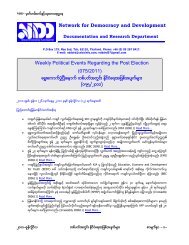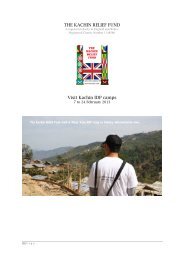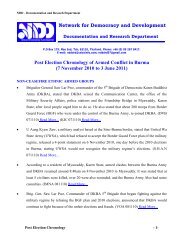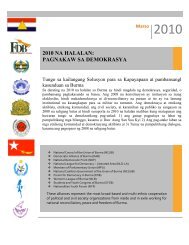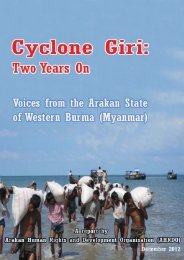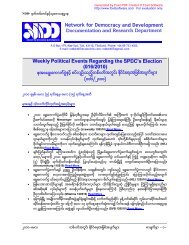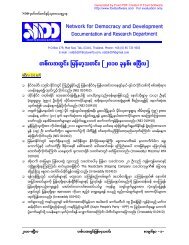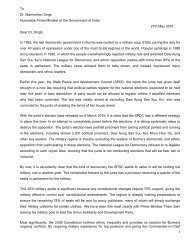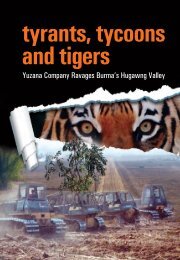The case for revenue transparency in the oil and gas ... - La'o Hamutuk
The case for revenue transparency in the oil and gas ... - La'o Hamutuk
The case for revenue transparency in the oil and gas ... - La'o Hamutuk
You also want an ePaper? Increase the reach of your titles
YUMPU automatically turns print PDFs into web optimized ePapers that Google loves.
Timor Leste:<br />
Revenues used <strong>for</strong> social development <strong>and</strong> environmental protection<br />
After a turbulent history of colonization <strong>and</strong> occupation by Portugal,<br />
Japan, <strong>and</strong> Indonesia, Timor Leste, previously known as East Timor,<br />
became an <strong>in</strong>dependent state <strong>in</strong> 2002. Though nearly all of <strong>the</strong> country’s<br />
<strong>in</strong>frastructure was destroyed by depart<strong>in</strong>g Indonesian <strong>for</strong>ces <strong>in</strong> 1999,<br />
<strong>the</strong> resource rich country has worked to rebuild <strong>and</strong> to establish a<br />
work<strong>in</strong>g democracy. Part of this challenge <strong>in</strong>cludes decisions over <strong>the</strong><br />
use <strong>and</strong> development of Timor Leste’s considerable natural <strong>gas</strong> <strong>and</strong> <strong>oil</strong><br />
resources.<br />
Timor Leste boasts estimated natural <strong>gas</strong> reserves of around 10 tcf <strong>and</strong><br />
estimated <strong>oil</strong> reserves of 959 million barrels (though approximately<br />
40% may be taken by o<strong>the</strong>r countries under treaties <strong>and</strong> agreements). 88<br />
Thus far, <strong>the</strong> country’s largest reserve is <strong>the</strong> Greater Sunrise natural <strong>gas</strong><br />
field, which is roughly comparable <strong>in</strong> size to Burma’s Shwe reserves. <strong>The</strong><br />
offshore <strong>gas</strong> field is located with<strong>in</strong> <strong>the</strong> Jo<strong>in</strong>t Petroleum Development<br />
Area, which is shared by Timor Leste <strong>and</strong> Australia accord<strong>in</strong>g to <strong>the</strong><br />
2002 Timor Sea Treaty. While <strong>revenue</strong>s from <strong>the</strong> Greater Sunrise <strong>gas</strong><br />
are to be shared with Australia, Timor Leste will receive an estimated<br />
10 to 16 billion USD over several decades. 89<br />
Three ma<strong>in</strong> legislative devices have been <strong>in</strong>stituted to ensure <strong>the</strong><br />
management of resource <strong>revenue</strong>s <strong>in</strong> Timor Leste: <strong>the</strong> Petroleum<br />
M<strong>in</strong><strong>in</strong>g Code, <strong>the</strong> Petroleum Tax Law <strong>and</strong> <strong>the</strong> Petroleum Fund Law. <strong>The</strong><br />
Petroleum M<strong>in</strong><strong>in</strong>g Code <strong>for</strong> <strong>the</strong> Jo<strong>in</strong>t Petroleum Development Area<br />
grants ownership of natural resources to <strong>the</strong> state, while declar<strong>in</strong>g that<br />
<strong>the</strong>y should be “used <strong>in</strong> a fair <strong>and</strong> equitable manner <strong>in</strong> accordance<br />
with national <strong>in</strong>terests.” This <strong>in</strong>cludes creat<strong>in</strong>g “m<strong>and</strong>atory f<strong>in</strong>ancial<br />
reserves” as well as environmental preservation. 90<br />
<strong>The</strong> Petroleum Tax Act sets out a specific taxation regime <strong>for</strong> petroleum<br />
activities <strong>in</strong> Timor Leste. <strong>The</strong> purpose is to provide maximum social<br />
economic benefit to Timor Leste <strong>and</strong> its people from petroleum<br />
resources. 91 Although this law has been established, en<strong>for</strong>cement is<br />
equally important as <strong>oil</strong> companies may not pay <strong>the</strong>ir taxes <strong>in</strong> full.<br />
<strong>oil</strong> <strong>and</strong> <strong>gas</strong> drill<strong>in</strong>g <strong>in</strong> Timor’s sea<br />
<strong>The</strong> structure to manage <strong>the</strong> f<strong>in</strong>ancial reserves m<strong>and</strong>ated by <strong>the</strong><br />
constitution was created <strong>in</strong> 2005 by <strong>the</strong> Petroleum Fund Law. 92 <strong>The</strong><br />
Law’s preamble emphasizes both <strong>the</strong> objective of benefit<strong>in</strong>g future, as<br />
well as current, generations <strong>and</strong> <strong>the</strong> goal of transparent management.<br />
Revenues from <strong>the</strong> development <strong>and</strong> sale of natural resources are to<br />
be deposited <strong>in</strong>to <strong>the</strong> Petroleum Fund, 93 <strong>and</strong> money from <strong>the</strong> Fund<br />
is to be transferred only <strong>for</strong> use <strong>in</strong> <strong>the</strong> state budget, subject to yearly<br />
limits. 94 Advice on <strong>the</strong> use of <strong>the</strong> Fund is provided by <strong>the</strong> Petroleum<br />
Fund Consultative Council, which conta<strong>in</strong>s representatives from civil<br />
society. 95 Be<strong>for</strong>e <strong>the</strong> Petroleum Fund Act was promulgated <strong>in</strong> 2005,<br />
several public consultations were held, reach<strong>in</strong>g thous<strong>and</strong>s of Timor<br />
28





